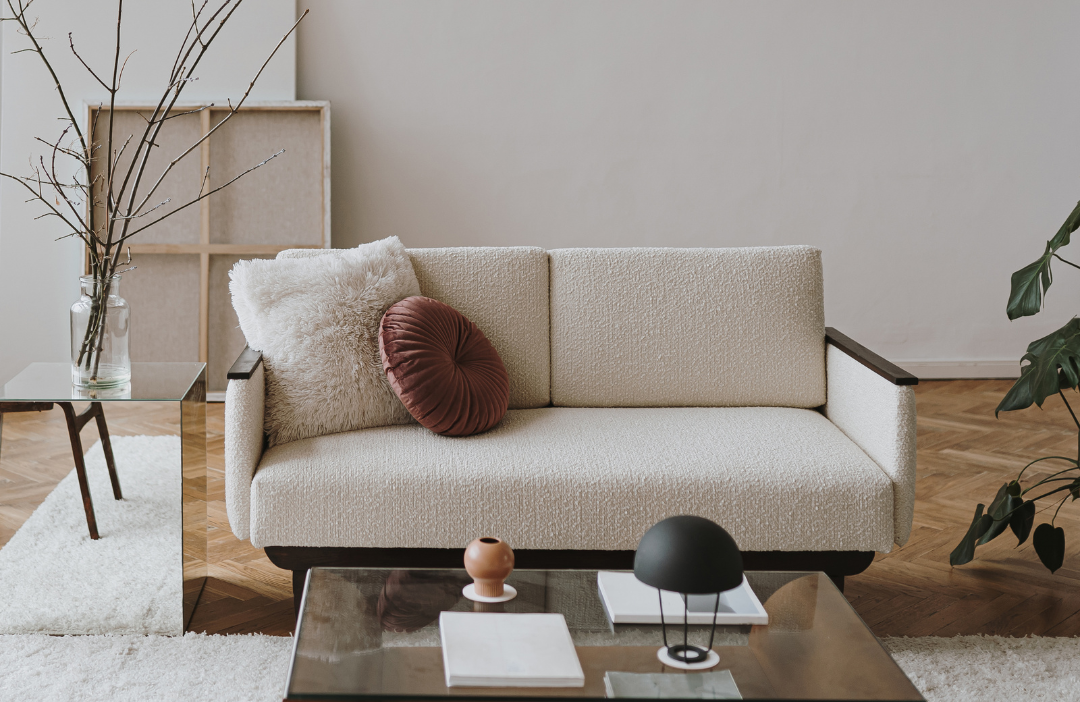In this sustainable furniture guide, we’re taking a room-by-room approach to transforming your home. Whether you’re tackling the living room, bedroom, office, or even your outdoor space, we’ve got practical, eco-friendly furniture solutions for every corner of your living space. Read on to learn more about the worst and best materials and the most trusted ethical furniture brands to fine-tune your space and keep your family safe.
Our Ultimate Guide to Ethical, Sustainable Furniture
Sure, switching to sustainable furniture can feel like a daunting task. I’ve been there—overwhelmed, not sure where to start, and wondering if I’d have to sacrifice style (and a chunk of my budget) just to make more eco-friendly furniture choices.
When you first start swapping out pieces in your home, it WON’T happen overnight. Your couch wasn’t suddenly sprouting FSC-certified wood legs and your dining table didn’t magically turn into reclaimed wood. It is a process—one room at a time, one piece at a time. I found that easing into it made all the difference. Instead of feeling the pressure to go 100% eco-friendly all at once, I took baby steps.
First, I focused on finding a non-toxic mattress and an organic pillow. A few months after that, I replaced my couch with a non-toxic sofa that my family could lounge on without inhaling questionable chemicals. Then, I moved on to adding rugs made from natural fibers and so on.
So, take it from someone who’s been on this journey—you don’t need to revamp your whole house overnight. The most important first step is to make a list of all your favorite ethical furniture brands and remove all fast-fashion furniture suggestions from EVERYWHERE.
What is Fast Furniture Exactly?
To put it simply, fast furniture is the fast fashion of the furniture world. It’s cheap, trendy, and mass-produced, but it often comes with a hidden cost—both to your wallet and the environment. Think of those trendy coffee tables or that affordable couch that you picked up because it looked cute for now, but maybe won’t last you for more than a couple of years. It’s designed to be replaced almost as fast as those changing decor trends you see on your Tiktok feed.
But, what makes fast furniture so bad for us and the planet?
The Environmental Impact of Fast Furniture
Every year, over 12 million tons of furniture waste end up in U.S. landfills alone. We can only imagine how high the global figure is! There are two big reasons why this is the new norm. First, home decor trends change constantly, and second, while cute, fast furniture won’t last more than a few years at most.
Unlike sustainable furniture brands, fast-furniture companies opt for materials like particleboard, low-grade plastics, and synthetic fabrics to cut down the manufacturing costs and make an even bigger profit. However, those non-renewable resources require a lot of energy to produce but don’t have the longevity to justify that consumption. This means more trees fell, more oil extracted, and more synthetic chemicals used—all for products designed to hit the trash within a few years.
The large-scale production and transportation of fast furniture contribute heavily to global carbon emissions. Think about it: manufacturing plants running on fossil fuels, raw materials shipped across continents, and delivery trucks zipping around to get your new dresser to your doorstep.
Not only does that lead to extra trips to the landfill, but it also encourages more consumption. You’re basically stuck in a cycle of “buy, use, trash, repeat.”
It’s not just the huge environmental impact that should make you second-guess your $50 coffee table. These furniture pieces are also laden with toxic chemicals that can severely impact the health of everyone in your household.
Because those viral social media hauls, especially from influencers, can easily hold us back from making mindful, ethical furniture choices. It’s tempting, right? You see a sleek new couch or trendy coffee table that seems to complete their space in a 30-second reel, and suddenly, it’s in your cart.
But in reality, these fast-fashion pieces aren’t built to last—and neither is the trend they’re based on.
The Most Toxic Materials in Furniture
Your comfy, Pinterest-worthy couch or chic coffee table could be harboring toxins that affect your health and the environment in some seriously sneaky ways. The shocking reality is that our home’s indoor air can be 2 to 5 times more polluted than the outdoor air, thanks to furniture and other household products. This statistic alone was enough to make us turn to sustainable furniture.
Formaldehyde
Formaldehyde is pretty much everywhere around us. But when it comes to furniture, you can easily spot it in some of the most commonly used materials. Particleboard, plywood, and medium-density fiberboard (MDF). Formaldehyde is a volatile organic compound (VOC), which means it easily evaporates into the air and contributes to indoor air pollution. It can release toxic fumes for years, even though you probably won’t see or smell it. The U.S. Environmental Protection Agency (EPA) has classified formaldehyde as a probable human carcinogen, and it’s also been linked to respiratory issues, skin irritation, and allergies.
Volatile Organic Compounds (VOCs)
Besides formaldehyde, there are a variety of other VOCs that can be found in paints, finishes, adhesives, and even foam cushions. These chemicals evaporate at room temperature and float around your home. Prolonged exposure to VOCs can lead to headaches, dizziness, respiratory issues, and in more severe cases, can contribute to the development of chronic diseases like asthma. And because VOCs are so prevalent in modern furniture, they can continuously seep into your air for years.
Flame Retardants
You’ll find flame retardants in foam and fabric-covered furniture, especially in older couches, chairs, and mattresses. These chemicals are added to meet safety regulations, but it turns out they may not even provide substantial fire protection. Worse, they’ve been linked to hormone disruption, lowered IQ in children, reproductive issues, and even cancer. In fact, several flame retardants have been identified as substances of very high concern (SVHC), meaning their long-term exposure is hazardous. People with asthma, allergies, or other respiratory conditions can experience flare-ups from prolonged exposure to these toxins. A Harvard study found that improving indoor air quality significantly boosts cognitive function and overall well-being.
PVC and Plastic-Based Fabrics
PVC (polyvinyl chloride) and other plastic-based materials are commonly found in synthetic leather, vinyl upholstery, and even in cushion foams. In most cases, they are packed with phthalates and other chemicals that can leach out over time. Phthalates, in particular, are notorious for disrupting the endocrine system, affecting reproductive health, and potentially increasing the risk of obesity and type 2 diabetes.
Luckily, there are dozens of ethical furniture brands, ready to outfit our humble adobes with healthy, safe, and sustainable furniture for every room and aesthetic.
What is Sustainable Furniture?
What exactly makes a piece of furniture sustainable, we hear you ask? In simple terms, it’s furniture designed and manufactured with minimal impact on the environment, using ethical production methods and materials that are good for both you and Mother Earth. First off, sustainable furniture is built from materials that are renewable, recyclable, or responsibly sourced. Think FSC-certified wood, recycled metals, or bamboo. These materials either regenerate quickly or come from recycled sources, meaning they don’t deplete natural resources or contribute to deforestation.
But it’s not just what goes into the furniture; it’s also about how it’s made. Eco-friendly furniture brands use ethical manufacturing processes that prioritize energy efficiency, waste reduction, and fair labor practices. They take steps to minimize their carbon footprint, whether by using renewable energy in production, reducing packaging waste, or cutting down on emissions from shipping. Some companies even take it a step further by creating pieces that can be easily disassembled and recycled at the end of their life.
What is Ethical Furniture?
In a nutshell, ethical furniture is created with respect for people, animals, and the planet. This means that every step of the production process, from the materials used to the labor practices, is done with fairness, transparency, and accountability. 2024’s most ethical furniture brands are very transparent about their fair labor practices, and guarantee that workers are paid fair wages, treated with dignity, and work in safe conditions.
No sweatshops or exploitative labor here! Instead, the emphasis is on supporting local artisans, fair trade cooperatives, or factories that uphold ethical standards. Some brands even go further by reinvesting in the communities where their furniture is made, contributing to local education, healthcare, or environmental initiatives.
Now that you have a pretty good idea of why sustainable furniture is the absolute best choice for a healthy home, let’s go over the safest materials and finishes.
The Most Sustainable Furniture Materials
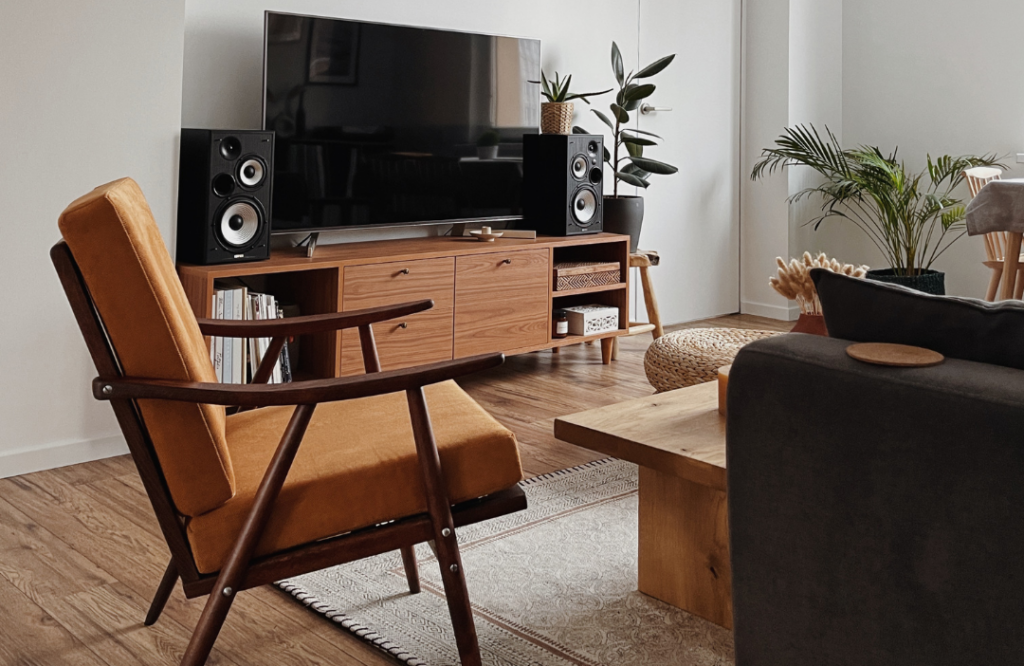
Organic FSC-Certified Wooden Furniture
Sustainable furniture made from FSC-certified wood is our absolute favorite pick! This certification from the Forest Stewardship Council verifies that the wood used comes from forests that are responsibly managed, meaning trees are harvested in ways that promote regeneration, protect wildlife, and support local communities. FSC-certified wood is not only beautiful and timeless, but it’s also incredibly durable—built to last for generations, not just a few seasons.
Using solid wood from a sustainable source reduces reliance on particleboard and plywood, which are often loaded with toxic chemicals like formaldehyde. Plus, opting for FSC-certified wood helps combat deforestation and supports ethical logging practices, so you can furnish your home with a clear conscience, knowing that your furniture has a minimal impact on the environment.
Recycled Furniture or Upcycled Materials
When we opt for eco-friendly furniture made from recycled or upcycled materials, we actively help to reduce waste while adding a unique, often modern touch to your home. Materials like recycled plastics, metals, and reclaimed wood offer durability without the need for new raw resources, diverting waste that might have otherwise ended up in landfills or polluting our oceans.
But what really made us fall in love with recycled sustainable furniture is the fact that they carry a distinct story and character, with designers creatively repurposing materials that might have been discarded. This not only cuts down on the energy used to produce new materials but also gives you a chance to own something truly one-of-a-kind.
Organic Fabrics and Natural Textiles
When it comes to upholstery and cushions, organic and natural textiles like organic cotton, linen, wool, and hemp are far superior to synthetic materials in both comfort and sustainability. These fabrics are grown without harmful pesticides or synthetic fertilizers, making them healthier for the environment and safer for your home. Organic cotton and linen are breathable and soft, while wool and hemp offer durability and natural resistance to pests and flames.
They are also biodegradable, which means they won’t sit in landfills for hundreds of years like polyester or nylon. On top of that, natural fabrics don’t off-gas harmful chemicals, helping maintain a healthier indoor air quality.
Bamboo Furniture
Bamboo is one of the fastest-growing plants on Earth, which makes it a fantastic choice for sustainable furniture. Unlike hardwoods that take decades to mature, bamboo can grow up to three feet in just a single day, and it doesn’t require replanting after harvest because it regenerates naturally.
Bamboo furniture is both lightweight and durable, offering the strength of hardwood without the environmental cost. It’s also resistant to moisture and pests, which makes it a great choice for both indoor and outdoor pieces. Plus, many bamboo products come with natural or low-VOC finishes to further minimize your and your family’s exposure to toxic chemicals.
Low-VOC Paints and Finishes
When furnishing your home, it’s not just the materials that matter, but the finishes, too. Low-VOC paints and finishes are essential for a sustainable, healthy living space. It’s no secret that traditional paints and varnishes release volatile organic compounds (VOCs) that contribute to indoor air pollution and can cause respiratory problems, headaches, and other health issues. Low-VOC or non-toxic finishes, on the other hand, offer a safer alternative that protects your furniture without filling your home with harmful fumes.
Cork
Harvested from the bark of the cork oak tree, this renewable resource doesn’t require cutting down the tree itself, allowing the bark to regenerate every few years. Cork is incredibly lightweight yet durable, making it an ideal material for furniture like stools, tables, and even flooring. Its natural elasticity and resistance to water and mold also make it an excellent choice for outdoor or damp environments. And to top it all off, cork furniture is fully biodegradable, meaning it won’t contribute to landfill waste at the end of its life.
Sustainable furniture alternatives not only last longer, but they also come with a lighter environmental footprint. We created a guide with eco-friendly furniture suggestions for every room. So, let’s start the detoxification process, shall we?
Step-by-Step Guide to Eco-Friendly Furniture for Every Room
Sustainable Living Room Furniture

- Eco-Friendly Couches— Go for sofas made with natural or recycled materials, like organic cotton, linen, hemp, or recycled polyester for the fabric. When it comes to the frame, FSC-certified wood (sustainably sourced wood) is a must. As for the stuffing—choose eco-friendly fillings like natural latex or recycled foam.
- Sustainable Coffee Tables — For coffee tables, go with reclaimed wood, bamboo, or upcycled materials treated with natural oils or water-based varnishes to reduce the demand for new resources but also add character and uniqueness to your space.
- Organic Chairs & Recliners — Just like with sofas, opt for chairs made with organic or recycled fabrics and FSC-certified wood or bamboo for the frame. Some sustainable furniture brands even offer fully recyclable or biodegradable chairs. Bonus points for choosing chairs with replaceable cushions or slipcovers to extend their lifespan.
- Sustainable Rugs — Choose organic rugs made from natural fibers like jute, hemp, wool, or organic cotton. Preferably hand-woven by artisans, supporting ethical labor practices.
- Eco-Friendly Shelving — Reclaimed wood shelves or modular shelving systems made from sustainable materials are excellent choices. If you’re up for it, repurposing crates or upcycling old ladders can create unique and eco-friendly shelving solutions.
- Sustainable Curtains & Window Treatments — Opt for natural fibers like organic cotton, linen, or bamboo, which are biodegradable and often require fewer chemicals in production. Thermal curtains can help regulate your home’s temperature, reducing your need for heating or air conditioning.
Sustainable Bedroom Furniture
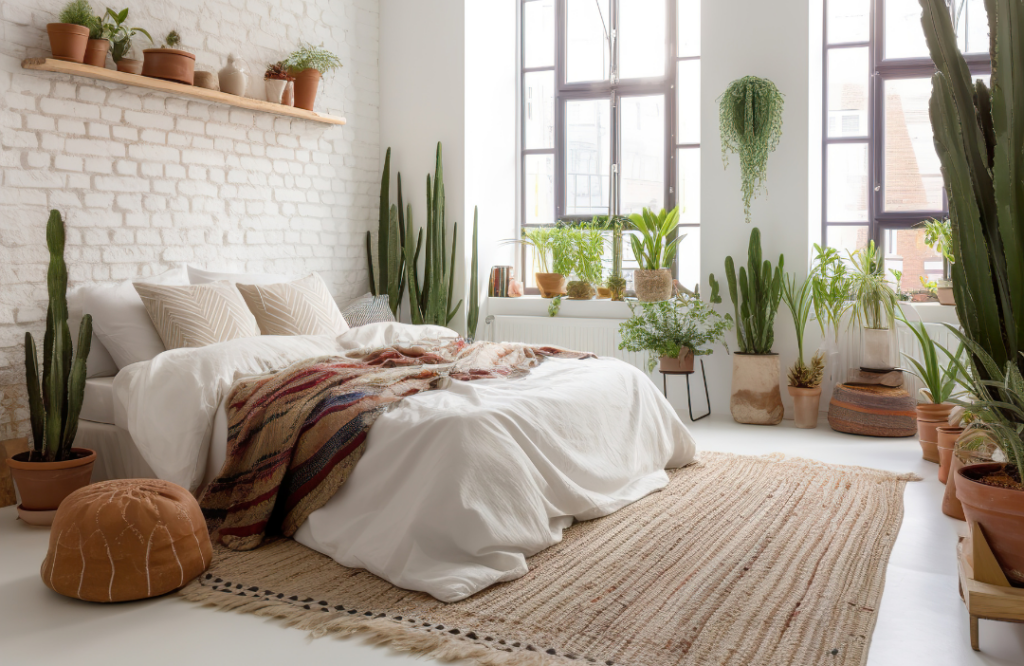
- Eco-Friendly Bed Frames — Invest in ethical bed frames made from sustainably sourced wood, like FSC-certified options, or even bamboo. Opt for a frame that’s sturdy, timeless, and easy to repair rather than replace.
- Organic Mattresses & Natural Pillows— Natural pillows and mattresses made from organic and natural materials like organic cotton, wool, or natural latex are completely free from harmful chemicals like flame retardants or VOCs. Stay away from synthetic foams and petroleum-based materials.
- Sustainable Dressers & Nightstands — Seek out solid wood options over particleboard or MDF, which are often held together with formaldehyde-based adhesives. Make sure any finishes used are low-VOC or water-based to reduce indoor air pollution.
- Eco-Friendly Bedding — For your sheets, blankets, and duvet covers, choose organic cotton, linen, bamboo, or hemp, and make sure they are all treated with eco-friendly dyes. Don’t go for conventional cotton because it’s notorious for its heavy water use and pesticide reliance.
- Sustainable Closets & Wardrobes — If you need extra storage, look for freestanding wardrobes made from reclaimed wood or bamboo. Verify that any wood used is FSC-certified and finished with non-toxic paints or stains. Modular closet systems made from eco-friendly materials can grow with you, reducing the need for replacements.
- Eco-Friendly Decor — Less is more when it comes to sustainable bedroom decor. Focus on meaningful pieces like upcycled picture frames, reclaimed wood wall art, or artisan-made sculptures. Plants are a fantastic, eco-friendly décor option that also purifies the air. Try indoor-friendly species like snake plants, peace lilies, or aloe vera.
Eco-Friendly Office Furniture

- Sustainable Office Desks — Always invest in ethical desks from sustainable furniture brands made from reclaimed wood, bamboo, or FSC-certified wood. Modular desks that can adjust or expand are great for future-proofing your workspace, avoiding the need to replace furniture as your needs grow. Stay far away from desks made from particleboard or MDF, which often contain formaldehyde and other harmful chemicals.
- Eco-Friendly Office Chairs — Go for office chairs made from sustainable materials like FSC-certified wood, recycled metals, or plant-based upholstery. Look for ergonomic designs with long-lasting materials like natural latex cushions or recycled foam. Avoid synthetic leather or vinyl—opt instead for fabrics like organic cotton, wool, or even Pinatex (a leather alternative made from pineapple leaves).
- Eco-Friendly Filing Cabinets — Need extra storage? Choose eco-friendly cabinets made from steel or wood that are either recycled or sustainably sourced. Metal filing cabinets can often be found second-hand and can be refurbished with a fresh coat of low-VOC paint for a new look.
Sustainable Dining Room Furniture
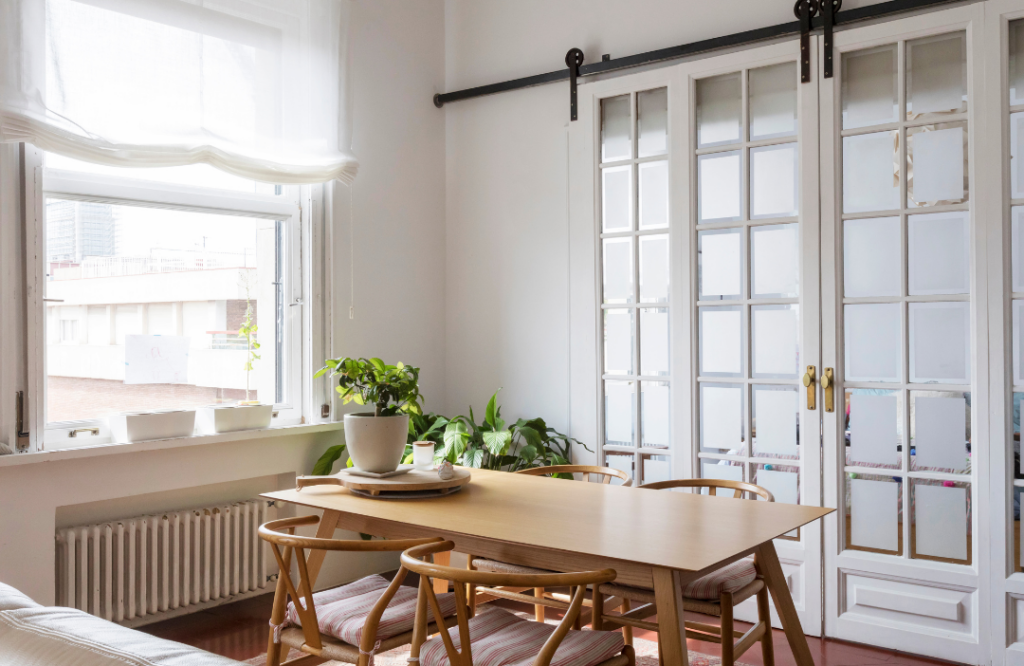
- Organic Dining Tables —Sustainable dining tables crafted from FSC-certified wood or reclaimed wood are the best choice. Bamboo is another fantastic choice since it’s fast-growing and highly renewable.
- Sustainable Dining Chairs — If the chairs are upholstered, look for fabrics like organic cotton, linen, hemp, or eco-friendly leather alternatives such as cork or Pinatex. Make sure any padding uses sustainable materials like natural latex or recycled foam, steering clear of synthetic fillers and finishes.
- Sustainable Dining Sets — Many brands now offer fully sustainable dining sets crafted from reclaimed or responsibly sourced wood. If you already have a table, mix and match it with second-hand or upcycled chairs for a unique, eco-friendly dining space.
- Eco-Friendly Sideboards & Buffets — Invest in timeless pieces made from reclaimed wood, bamboo, or metal that have been recycled. These furniture items tend to be larger, so it’s important to select ones that are durable and crafted with care to avoid waste. Low-VOC finishes and non-toxic adhesives should be non-negotiable.
- Sustainable Tableware — Always opt for plates, bowls, and utensils made from sustainable materials like bamboo, recycled glass, or ceramic. Ceramic and porcelain are excellent because they’re long-lasting and often made from natural materials. Bamboo utensils are biodegradable, and stainless steel flatware can last generations.
- Eco-Friendly Napkins & Table Linens — Skip the single-use paper napkins and go for reusable ones made from organic cotton, linen, or hemp. These natural fibers are not only sustainable but also incredibly durable, meaning they’ll last for years of meals and washings. The same goes for tablecloths and placemats—choose materials that are easy to care for and free from harmful dyes or chemicals.
Eco-Friendly Outdoor Furniture
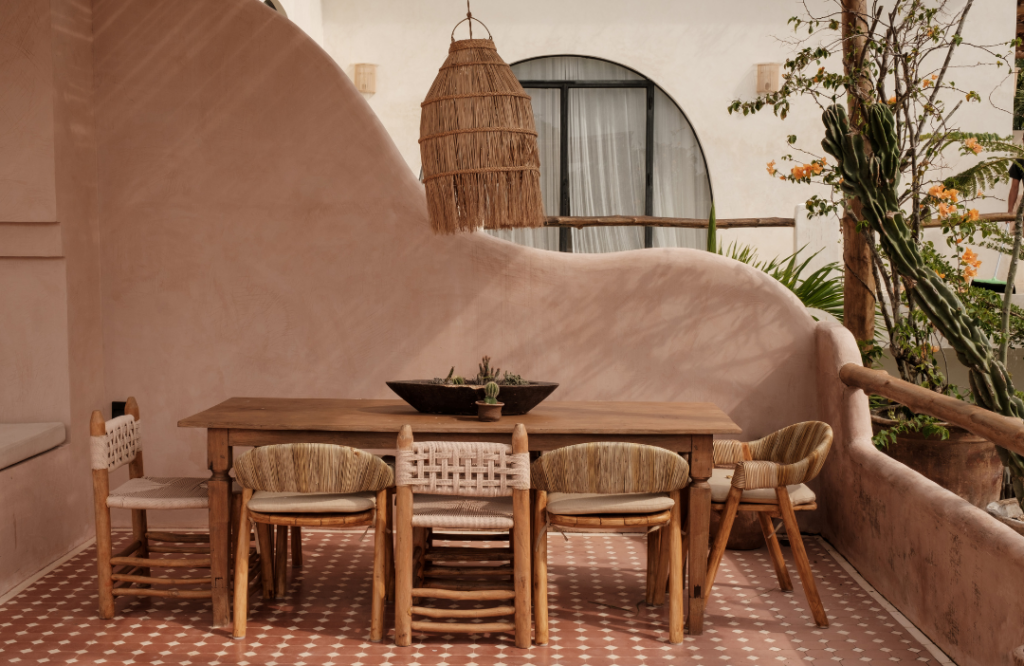
- Eco-Friendly Outdoor Chairs —Outdoor furniture should be durable and weatherproof, so make sure to opt for materials like FSC-certified wood, bamboo, or recycled plastic. Recycled plastic furniture is surprisingly eco-friendly—it diverts waste from landfills and oceans and is extremely weather-resistant. If you prefer a more natural look, chairs made from sustainably harvested teak or eucalyptus wood are great choices, as these woods are naturally weatherproof.
- Sustainable Outdoor Dining Tables — Tables made from reclaimed wood, recycled metal, or bamboo are perfect for alfresco dining. Teak and eucalyptus are particularly great options because of their weather resistance and longevity. Make sure the table has a non-toxic, weatherproof finish to protect it from the elements without releasing harmful chemicals into the environment.
- Recycled Plastic Outdoor Furniture – One of the most eco-friendly options for outdoor furniture is recycled plastic. It’s made from post-consumer waste, like old milk jugs or plastic bottles, and is designed to withstand the toughest weather conditions. Plus, it’s available in various styles, from Adirondack chairs to picnic tables. This type of furniture is long-lasting and low-maintenance, which means fewer replacements over time.
- Sustainable Hammocks — Nothing says “relaxation” like a hammock, and you can swing sustainably, too! Look for hammocks made from organic cotton, recycled polyester, or even upcycled materials.
Bonus: Multifunctional and Modular Furniture for Small Spaces
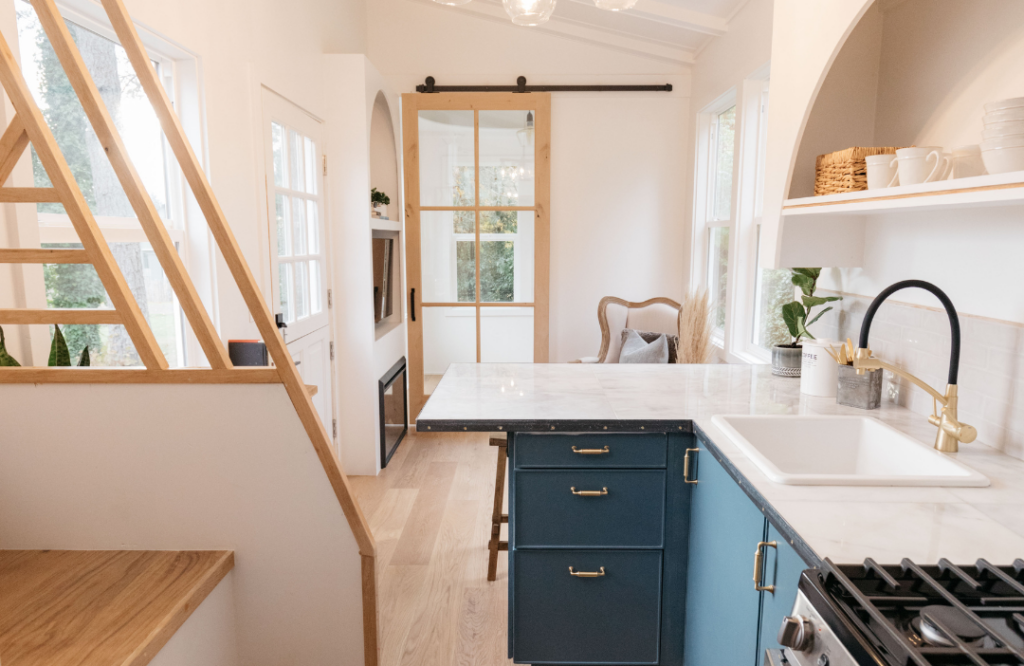
Whether you’re living in a tiny apartment or trying to make the most of a compact room, with eco-friendly multifunctional furniture, you can reduce the amount of furniture you need, which means fewer resources used in production, less waste, and a smaller carbon footprint. In small spaces, every piece of furniture should work harder and smarter by offering more than one function, allowing you to live big in a small space while staying green.
My first tip is to think vertical. In small spaces, you need to use every inch wisely, including vertical space. Wall-mounted shelves, hooks, and foldable furniture can help you declutter while keeping the floor clear. Look for shelving made from reclaimed wood or metal, and consider upcycling materials like old crates for a DIY touch.
- Sofa Beds & Sleeper Sofas — Prefer organic sofa beds made from FSC-certified wood frames or recycled steel, with eco-friendly upholstery like organic cotton, linen, or recycled polyester. Some sustainable furniture brands even offer modular designs that allow you to reconfigure your seating as needed. Choose mattresses made from natural latex or organic cotton to keep it green inside and out.
- Convertible Dining & Coffee Tables — Space-saving tables are essential for small apartments or homes. Opt for convertible dining tables that can extend or fold down when not in use, minimizing space and materials. Many modular tables are made from FSC-certified wood or recycled metals. Some coffee tables also come with hidden storage or adjustable heights, doubling as desks, dining surfaces, or extra storage.
- Stackable & Nesting Furniture — Stackable chairs, stools, or nesting tables are perfect for multifunctional living. When not in use, they can be tucked away or stored vertically, freeing up floor space. Go for sustainable pieces made from sustainable materials like reclaimed wood, bamboo, or recycled plastics. The best part? They’re ideal for small homes that occasionally host larger groups.
The Best Ethical Furniture Brands in 2024
- West Elm — Known for its modern designs, West Elm sources sustainable materials and partners with Fair Trade-certified artisans to create stylish, ethical furniture for every room.
- The Futon Shop — Specializing in organic and eco-friendly futons and mattresses, The Futon Shop uses natural materials and sustainable production methods for healthier sleep.
- Saatva — Touted for its luxury mattresses, Saatva prioritizes sustainable materials and ethical practices in its production, offering eco-friendly options for a comfortable sleep.
- Brentwood Home — This sustainable home brand focuses on creating high-quality mattresses and furniture using natural and organic materials, all while maintaining eco-friendly manufacturing processes.
- Joybird —To create beautiful, mid-century modern furniture, Joybird uses responsibly sourced materials and offers customizable pieces to fit your sustainable style.
- Crate & Barrel — This popular retailer features a range of sustainable furniture options, including items made from reclaimed wood and eco-friendly materials, all while focusing on quality and design.
- Made Trade — This online marketplace features ethically sourced and sustainably made home goods, including furniture from various artisans and brands committed to fair labor practices.
- The Citizenry — Focused on artisanal craftsmanship, The Citizenry partners with artisans from around the world to create unique, ethically made furniture and home decor.
- Burrow — Offering modular sustainable furniture that’s easy to assemble and disassemble, Burrow focuses on sustainability by using recycled materials and reducing waste.
- Ethan Allen — With a commitment to sustainability, Ethan Allen has introduced a range of furniture made from responsibly sourced materials and offers eco-friendly upholstery options.
- Floyd — This brand focuses on modular furniture that’s easy to move and adapt, using sustainable materials to create stylish, practical solutions for small spaces.
Check out the complete brand list here.
Certifications to Look For in Sustainable Furniture
Here’s a complete list of the most trusted certifications to guide your eco-friendly furniture choices.
- FSC (Forest Stewardship Council) Certification —Guarantees that wood products come from responsibly managed forests that provide environmental, social, and economic benefits.
- GREENGUARD Certification — Certifies that furniture meets strict chemical emissions limits, contributing to healthier indoor air quality by reducing pollutants.
- Cradle to Cradle Certified — Evaluates a product’s safety to humans and the environment, focusing on circularity in design—how materials can be reused, recycled, or safely returned to the earth.
- Global Organic Textile Standard (GOTS) — Applies to furniture textiles, confirming that fabrics like cotton, linen, or wool are organic and produced using environmentally friendly processes.
- OEKO-TEX Standard 100 — Verifies that textiles used in furniture are free from harmful substances, from raw materials to finished products, ensuring consumer health and safety.
- SCS Global Services Certification — Covers multiple certifications, including recycled content, indoor air quality, and sustainable forestry, focusing on transparency and sustainability claims.
- BIFMA LEVEL Certification — Recognizes furniture that meets rigorous environmental, social, and corporate responsibility criteria, aimed specifically at the commercial furniture industry.
- Rainforest Alliance Certification — Indicates that wood and other forest-based materials are sourced in a way that supports sustainable land use, biodiversity, and local communities.
- Fair Trade Certified —Applies to furniture made with fair trade materials or by artisans in developing countries, supporting fair wages, safe working conditions, and community development.
- bluesign® Certification —For textiles and upholstery, confirming that fabrics are produced with minimal environmental impact, focusing on reducing harmful chemicals in production.
- Ecolabel (EU Ecolabel) – A European certification that covers a wide range of furniture products, focusing on environmental impact across the entire life cycle, from raw materials to disposal.
- NAPM Recycled Certification —Verifies the use of recycled materials in furniture, particularly in office furniture and accessories, promoting the use of post-consumer recycled content.
- CarbonNeutral® Certification — Indicates that the product or company has offset its carbon emissions to achieve carbon neutrality, helping to reduce the overall environmental impact.
- Eco-INSTITUT Certification — Certifies that furniture is free from harmful emissions and pollutants like VOCs (volatile organic compounds), heavy metals, and formaldehyde.
- SA8000 — A social certification that guarantees furniture is produced under fair labor conditions, including ethical treatment of workers and safe working environments.
- CertiPUR-US — Specifically for foam in mattresses, cushions, and upholstered furniture, this certification ensures that the foam is free from harmful chemicals like formaldehyde, mercury, or PBDE flame retardants.
- MADE SAFE® Certification — Guarantees that materials and ingredients used in furniture are safe for humans and the environment, excluding toxic chemicals and pollutants.
- Better Cotton Initiative (BCI) — Verifies that cotton used in furniture textiles is grown sustainably, reducing environmental impacts and improving the livelihood of cotton farmers globally.
Final Thoughts On Ethical, Sustainable Furniture
There you have it – our best tips for choosing sustainable furniture that is equal parts stylish and ethical. Switching to eco-friendly furniture means investing in quality, reducing waste, and supporting fair labor practices. And remember, you don’t have to overhaul your entire home overnight. Every little step counts. Whether it’s swapping out that worn-out coffee table for a reclaimed wood beauty or choosing organic textiles for your bedroom, you can slowly transform your space into a sustainable sanctuary.
